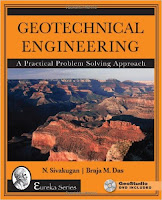Analysis of Structures on Elastic Foundations
Edward Tsudik ... 600 pages - Publisher: J. Ross Pub.; (October 2, 2012)
Language: English - ISBN-10: 1604270748 - ISBN-13: 978-1604270747
Analysis of Structures on Elastic Foundations is a practical guide for structural and geotechnical engineers as well as graduate students working in foundation engineering. The author provides practical methods of analysis and describes in detail various foundations, including simple beams on elastic foundations, and very complex foundations such as mat foundations supported on piles. Methods for fast and easy hand analysis in addition to methods for exact computer analysis are presented. Most of the methods are for three soil models: Winkler foundation, elastic half-space, and elastic layer. Numerical examples throughout the book illustrate the applications of these methods.
Key Features: -Offers simple formulas and tables for the analysis of beams free-supported on Winkler foundation and elastic half-space as well as applications to the analysis of complex beams and many types of continuous beams -Describes in detail the little-known method of initial parameters that allows the analysis of indeterminate systems with elements supported on Winkler foundation -Covers a new and very simple method of combined analysis of 2D and 3D frames with individual foundations by modeling the system soil-foundation with equivalent line elements and without requiring special software -Introduces a series of new methods/algorithms such as the analysis of composite beams and plates on elastic foundations, combined analysis of walls with continuous foundations, and combined analysis of walls supported on frames with continuous and individual foundations
Language: English - ISBN-10: 1604270748 - ISBN-13: 978-1604270747
Analysis of Structures on Elastic Foundations is a practical guide for structural and geotechnical engineers as well as graduate students working in foundation engineering. The author provides practical methods of analysis and describes in detail various foundations, including simple beams on elastic foundations, and very complex foundations such as mat foundations supported on piles. Methods for fast and easy hand analysis in addition to methods for exact computer analysis are presented. Most of the methods are for three soil models: Winkler foundation, elastic half-space, and elastic layer. Numerical examples throughout the book illustrate the applications of these methods.
Key Features: -Offers simple formulas and tables for the analysis of beams free-supported on Winkler foundation and elastic half-space as well as applications to the analysis of complex beams and many types of continuous beams -Describes in detail the little-known method of initial parameters that allows the analysis of indeterminate systems with elements supported on Winkler foundation -Covers a new and very simple method of combined analysis of 2D and 3D frames with individual foundations by modeling the system soil-foundation with equivalent line elements and without requiring special software -Introduces a series of new methods/algorithms such as the analysis of composite beams and plates on elastic foundations, combined analysis of walls with continuous foundations, and combined analysis of walls supported on frames with continuous and individual foundations





